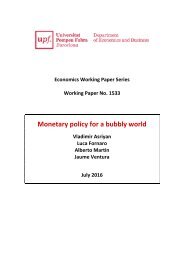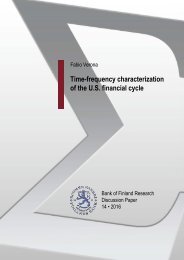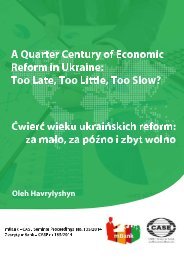Necessity as the mother of invention monetary policy after the crisis
n?u=RePEc:dnb:dnbwpp:525&r=mac
n?u=RePEc:dnb:dnbwpp:525&r=mac
Create successful ePaper yourself
Turn your PDF publications into a flip-book with our unique Google optimized e-Paper software.
“c<strong>as</strong>ual evidence suggests that QE h<strong>as</strong> been ineffective in incre<strong>as</strong>ing inflation.” More<br />
academic work is clearly needed.<br />
That said, <strong>the</strong>re is incre<strong>as</strong>ing evidence that <strong>as</strong>set purch<strong>as</strong>e programs have modest but not<br />
negligible effects beyond financial markets—on quantities like GDP and inflation. 17 For<br />
instance, Engen et al. (2015) find a peak effect on inflation <strong>of</strong> 0.5% and a peak effect <strong>of</strong><br />
unemployment <strong>of</strong> 1.25 percentage points in <strong>the</strong> Fed’s macroeconomic FRB/US model.<br />
Chung et al. (2012) find slightly larger effects, and emph<strong>as</strong>ize that QE prevented <strong>the</strong> U.S.<br />
economy from falling into deflation. Using simulation from a large Bayesian VAR-model,<br />
Churm et al. (2015) conclude that <strong>the</strong> second round <strong>of</strong> purch<strong>as</strong>es by <strong>the</strong> Bank <strong>of</strong> England<br />
incre<strong>as</strong>ed GDP by between 0.5% and 0.8%, while inflation w<strong>as</strong> affected by at most 0.6<br />
percentage points. Using a similar methodology, Weale and Wieladek (2016) estimate that<br />
announcing purch<strong>as</strong>es <strong>of</strong> 1% <strong>of</strong> GDP affects U.S. GDP by 0.58%, while <strong>the</strong> effects for <strong>the</strong><br />
U.K. are only 0.25%. In a follow-up study, Wieladek and P<strong>as</strong>cual (2016) examine <strong>the</strong> real<br />
effects <strong>of</strong> <strong>the</strong> ECB’s QE and conclude that in absence <strong>of</strong> <strong>the</strong> first round <strong>of</strong> QE, real GDP<br />
and core CPI in <strong>the</strong> euro area would have been 1.3%-points and 0.9%-points lower,<br />
respectively. The effect is roughly 2/3 times smaller than those <strong>of</strong> <strong>as</strong>set purch<strong>as</strong>e programs<br />
in <strong>the</strong> UK and <strong>the</strong> US. These are substantial effects.<br />
But <strong>the</strong> effects <strong>of</strong> QE almost certainly depend on <strong>the</strong> context. As one prominent example,<br />
<strong>the</strong> Fed’s purch<strong>as</strong>es <strong>of</strong> mortgage-backed securities (MBS) under QE1 took place in a<br />
distressed—indeed almost moribund—MBS market. But subsequent QE programs did<br />
not. Hence we should expect stronger effects from QE1 than from QE2, QE3, etc.<br />
Analogously, Goodhart and Ashworth (2012) argue that more recent <strong>as</strong>set purch<strong>as</strong>es by<br />
<strong>the</strong> Bank <strong>of</strong> England were subject to diminishing returns, given that gilt yields had already<br />
fallen to very low levels. A similar point w<strong>as</strong> raised when <strong>the</strong> ECB started its full-fledged<br />
QE program in 2015, <strong>as</strong> various euro area government bonds were <strong>the</strong>n trading at record<br />
low yields. More broadly, how can one disentangle <strong>the</strong> effects <strong>of</strong>, say, QE and forward<br />
guidance when <strong>the</strong> two are promulgated toge<strong>the</strong>r? As a fur<strong>the</strong>r complication,<br />
communication on future rates is <strong>of</strong>ten accompanied by guidance on future QE.<br />
3.4. Macro-prudential instruments: here to stay, but in what form?<br />
Given that most <strong>of</strong> our survey respondents have considered broadening <strong>the</strong> central bank’s<br />
mandate to include financial stability, it should come <strong>as</strong> no surprise that many see a<br />
continuing role for macro-prudential instruments. Roughly three-quarters <strong>of</strong> <strong>the</strong><br />
respondents, academics <strong>as</strong> well <strong>as</strong> governors, believe <strong>the</strong> macro-prudential element will<br />
remain a permanent feature in <strong>the</strong> new normal. Only a small percentage <strong>of</strong> respondents<br />
think <strong>the</strong> use <strong>of</strong> <strong>the</strong>se instruments should be discontinued (Table 6). Some in this latter<br />
group find it puzzling that a question on macro-prudential instruments is included in our<br />
survey, <strong>as</strong> <strong>the</strong>y do not think it should be a responsibility <strong>of</strong> <strong>the</strong> central bank, while o<strong>the</strong>rs<br />
find <strong>the</strong> concept too vague to begin with. Strikingly, <strong>as</strong> <strong>the</strong> paltry χ 2 statistic shows, <strong>the</strong><br />
views <strong>of</strong> academics and governors on this issue are statistically indistinguishable.<br />
17<br />
See also IMF (2013), in particular Table 3 <strong>of</strong> <strong>the</strong> Appendix, and de Haan and Sturm (2016) for overviews <strong>of</strong> recent studies.<br />
19








